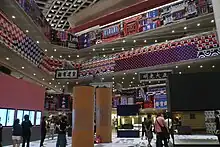Zuni Icosahedron
Zuni Icosahedron is a Hong Kong-based international experimental theatre company. Founded in 1982, Zuni is one of the nine major professional performing arts groups subsidised by the HKSAR government[1] and has produced more than 190 original productions of alternative theatre and multimedia performances. As well as theatre works, Zuni is also active in video, sound experimentation and installation art, as well as working in the areas of arts education, arts criticism, cultural policy research and international cultural exchange.[2]
The name Zuni Icosahedron expresses two essential elements of its theatre works: colour (zuni) and form (icosahedron). While "Zuni" stands for a colour between green and blue, "Icosahedron" is a twenty-sided object as well as a highly infectious virus.[3]
Over the years, Zuni has been invited to more than 30 cities in Europe, Asia, and America for cultural exchange and performances. In 2000, Zuni co-presented “Festival of Vision: Berlin / Hong Kong”, the first ever large-scale cultural exchange between Asia and Europe. In 2009, Zuni’s artistic director Danny Yung was awarded the Merit Cross of the Order of Merit by the German Federal Government in recognition of his contribution to arts and cultural exchange between Germany and Hong Kong.[4]

Since 2009, Zuni has been a venue partner of the Hong Kong Cultural Centre, producing a series of theatre works and outreach education programmes.[5]
Zuni is currently led by its co-artistic directors, Danny Yung and Mathias Woo.
Major theatre works
2010
- Experimenting Traditions Series: Stage Sisters (Director: Danny Yung)
- A Digital Opera in 7 Acts - The Memory Palace of Matteo Ricci (Director: Mathias Woo, Libretto: Diana Liao, Composer: Steve Hui)
- Remembrance of Karaoke Past (Director: Mathias Woo)
2011

- One Hundred Years of Solitude 10.0 – Cultural Revolution (Director: Danny Yung)
- Railway is Like a Long, Winding Recollection (Director: Mathias Woo)
- One Hundred Years of Chinese Architecture (Director: Mathias Woo)
- B.O.B.* The Final Cut (Choreographer: Dick Wong)
- Bauhaus Manifesto (Directors: Lai Tat Tat Wing, Cedric Chan)
Art education

Zuni has undertaken outreach to schools and the community by setting up an Art Education Unit since 1987. Over the years, it has designed and organised various creative education projects, including exhibitions, performances, workshops and cultural exchange activities. A notable example is the Black Box Exercise, which started in 1995, in which each participating students is given one 30 cm x 30 cm x 30 cm black box to create their own work. The exercise was brought to Kolkata, Mumbai, New Delhi in 2005 by the India Foundation for the Arts, and around 8,000 local artists, teachers and students has participated.[6][7]
In 2012, Zuni launched “Tian Tian Xiang Shang”, a Creativity-For-Community and School Development Programme, which includes a series of sculptures creations, workshops for primary and secondary students and exhibitions.[8][9]
Architecture is Art Festival
The Architecture is Art Festival (AIAF) is the biannual art festival presented by Zuni Icosahedron since 2009. With architecture as the central topic, a series of multimedia performances, traditional Chinese opera, exhibitions, seminars, conferences and student workshops are held at the Hong Kong Cultural Centre and other venues.[10] As Rossella Ferrari writes in her review in TDR, "(AIAF)...is a celebration of architecture and theatre or, rather, of architecture in theatre and architecture as theatre—the first of its kind in Asia and possibly worldwide."[11]
Gay-themed film festival
In 1985, Zuni held the first homosexuals film festival in its clubhouse in Causeway Bay, which was probably the first of its kind in Hong Kong.[12] Films selected included Bigger Splash, Boys in the Band, Querelle, Salò, or the 120 Days of Sodom, and Victor Victoria.
People
Zuni’s experimental spirit has nurtured generations of talent, with many former members now practising in the design industry, popular media and cultural infrastructure in various areas. These people include lyricist Wyman Wong, stage director Edward Lam, comic artist Lai Tat Tat Wing, styling and costume designer Tomas Chan, cinematographer Kwan Pun Leung, choreographer Dick Wong, writer and visual artist Craig Au Yeung, singer Anthony Wong, commentator and cultural critic Leung Man-tao, and film director Susie Au.
External links
References
- "Hong Kong Yearbook 2010" (PDF). Retrieved 17 May 2020.
- Zuni Icosahedron official website
- Lilley, R. (1990). Staging Hong Kong: Gender and Performance in Transition. Honolulu: University of Hawai’i Press.
- "網頁轉駁中 Redirecting..." www.hkadc.org.hk. Retrieved 17 May 2020.
{{cite web}}: Cite uses generic title (help) - "Venue Partners". Archived from the original on 13 May 2012. Retrieved 7 May 2012. LCSD Venue Partnership Scheme
- "Mohile Parikh Center: Black Box Exercise: An Arts Education Program". Archived from the original on 4 March 2016. Retrieved 21 May 2019.
- "ZUNI". Archived from the original on 18 December 2012. Retrieved 17 May 2020.
- "Mao Zedong Photo Gallery: Latest Pictures, Best News Photos, Images about on Mao Zedong". Firstpost. Retrieved 17 May 2020.
- "CREATEHK - CreateSmart Initiative". www.createhk.gov.hk. Retrieved 17 May 2020.
- "Architecture is Art Festival". Archived from the original on 20 August 2012. Retrieved 21 May 2019.
- Ferrari, Rossella (2011) 'The Stage as a Drawing Board: Zuni Icosahedron’s Architecture Is Art Festival.' TDR: The Drama Review, 55 (1). pp. 137-149.
- "[Zuni Icosahedron Newsletter] Cinema & Homosexuals (Jan 1985) | LGBT Hong Kong". Archived from the original on 28 January 2013. Retrieved 17 May 2020.